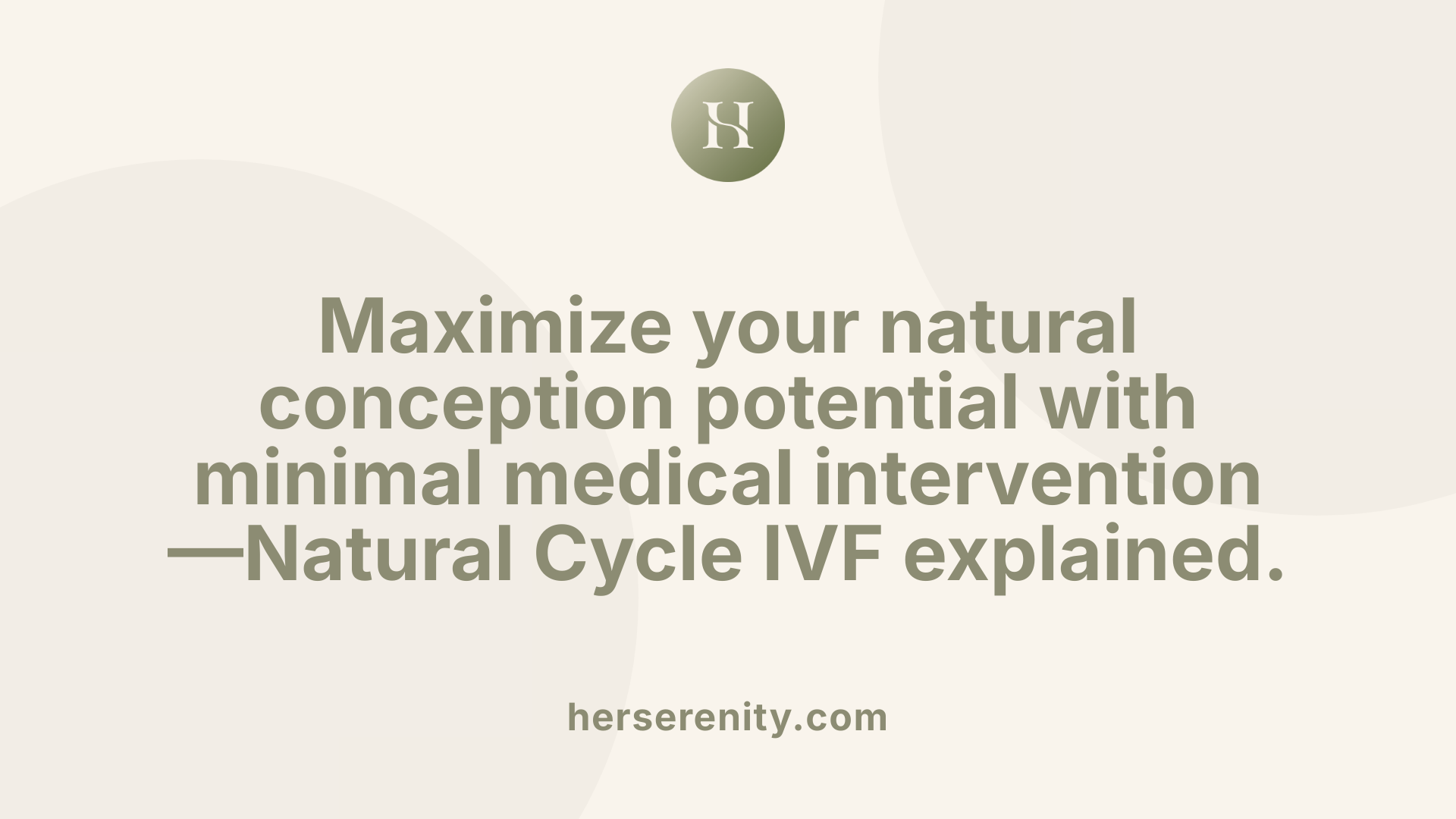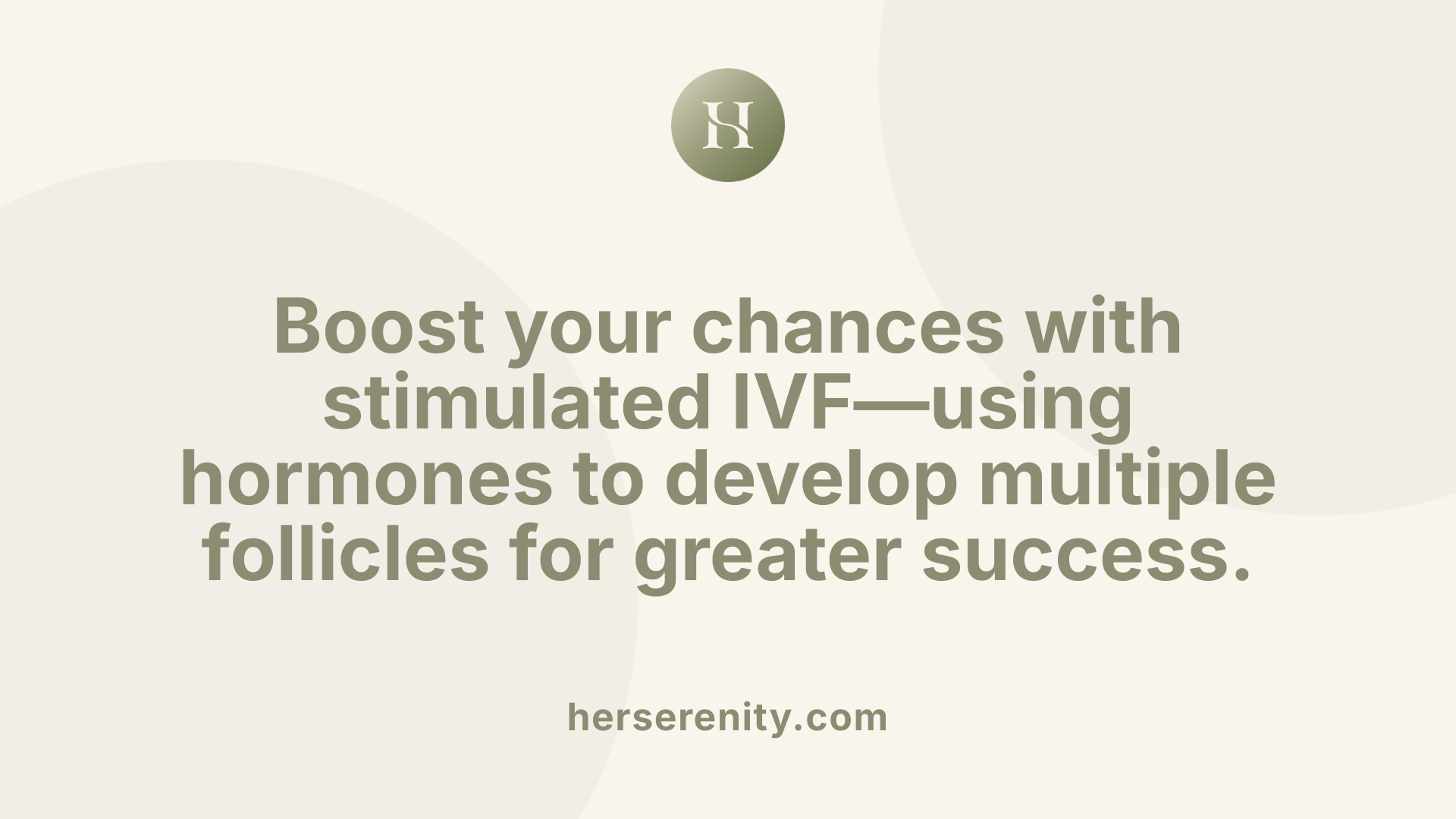Understanding IVF and Its Variants
In vitro fertilization (IVF) offers hope to many couples facing infertility challenges. Among the IVF approaches, two primary methods exist: natural cycle IVF and stimulated IVF. Each has distinct protocols, advantages, risks, and success rates. This article delves into their differences, medical considerations, psychological impacts, and suitability to help readers make informed decisions about fertility treatments.
The Basics of Natural Cycle IVF: Minimal Intervention, Natural Ovulation

What is Natural Cycle IVF and How Does It Work?
Natural cycle IVF is an assisted reproductive technology that closely follows a woman's natural menstrual cycle without the use of ovarian stimulation drugs. Rather than stimulating the ovaries to produce multiple eggs, this method focuses on monitoring the natural development of a single dominant follicle and egg. Throughout the cycle, ultrasounds and hormone blood tests are used to precisely identify when ovulation occurs. Once the egg is mature, it is retrieved, fertilized in the laboratory, and then transferred back to the uterus.
Use of No or Minimal Ovarian Stimulation Drugs
Unlike stimulated IVF, natural cycle IVF involves no or minimal use of fertility medications. Typically, no injectable drugs are administered to induce multiple follicle development. Occasionally, a small dose of hCG may be given to trigger final egg maturation. This drug-free or low-medication approach reduces side effects and complications often linked to hormonal stimulation.
Monitoring and Egg Retrieval Aligned with Natural Ovulation
The treatment requires careful monitoring through ultrasound scans and blood hormone levels to track the dominant follicle's growth. The timing of egg retrieval is coordinated with the body's natural ovulation signals, such as the luteinizing hormone (LH) surge. This precise timing ensures the retrieval of a mature egg without the use of external stimulation.
Who is Natural Cycle IVF Suitable For?
Natural cycle IVF is especially suitable for women who have a good ovarian reserve and regular ovulation. It offers a less invasive and more cost-effective option for those preferring to avoid fertility drugs. Women with conditions such as poor response to stimulation, or those who have previously experienced side effects from stimulation drugs, may also benefit from this method.
How Does Natural Cycle IVF Help Couples Conceive?
By harnessing the body's natural cycle, this method helps couples conceive with minimal medical intervention. One mature egg is retrieved and fertilized in the lab, increasing the chances of pregnancy while minimizing drug risks. Although success rates per cycle tend to be lower than stimulated IVF, natural cycle IVF offers a safer and more natural pathway for many patients.
Stimulated IVF: Harnessing Hormonal Stimulation to Increase Success

What is stimulated IVF and how does it work?
Stimulated IVF is a fertility treatment method that uses fertility medications to encourage the ovaries to develop multiple follicles within a single menstrual cycle. This approach increases the number of eggs retrieved, boosting the likelihood of fertilization and pregnancy.
What fertility medications are involved in stimulated IVF?
Medications commonly used include follicle-stimulating hormone (FSH), human chorionic gonadotropin (hCG), and gonadotropin-releasing hormone (GnRH) analogs. FSH stimulates the growth of multiple ovarian follicles, hCG triggers egg maturation and ovulation timing, and GnRH analogs help control hormone levels to prevent premature ovulation.
How does the ovarian stimulation process increase success?
By producing multiple follicles, stimulated IVF maximizes the number of mature eggs available. This increases the chances of collecting viable eggs during retrieval, fertilizing them in the laboratory, and selecting the best embryos for transfer. Additionally, excess embryos can be frozen for future cycles, improving cumulative success rates.
What are the steps following ovarian stimulation?
After hormonal stimulation, eggs are retrieved through a minimally invasive procedure. Fertilization occurs in the lab—either through conventional insemination or intracytoplasmic sperm injection (ICSI). The resulting embryos may undergo genetic testing options such as Preimplantation Genetic Testing for Aneuploidy (PGT-A), Monogenetic diseases (PGT-M), or Structural Rearrangements (PGT-SR). Following selection, embryos are transferred to the uterus to achieve pregnancy.
How do assisted reproductive technologies (ART) support conception?
Stimulated IVF is a prime example of ART, leveraging controlled ovarian stimulation to produce multiple eggs and enhance pregnancy chances. Genetic testing and embryo freezing further optimize outcomes and allow personalized treatment. This comprehensive approach helps couples facing infertility maximize their chances of conception successfully and efficiently.
Comparing Success Rates: Quantity versus Quality of Eggs
How do success rates compare between natural cycle IVF and stimulated IVF?
Success rates differ notably between natural cycle IVF (NC-IVF) and stimulated IVF. Natural cycle IVF typically has a pregnancy rate around 10-16.7% per cycle, reflecting retrieval of a single egg. Stimulated IVF often achieves higher success, with live birth rates up to 85.8% for women under 35 due to multiple eggs retrieved per cycle and availability of embryo freezing.
How does the number of eggs retrieved impact pregnancy chances?
Stimulated IVF’s use of fertility drugs leads to multiple follicle development and several eggs retrieved, significantly increasing the odds of fertilization and embryo implantation. Natural cycle IVF usually yields only one egg, limiting immediate pregnancy potential but reducing risks like ovarian hyperstimulation syndrome and multiple pregnancies.
Is egg quality different between the two methods?
Natural cycle IVF tends to produce eggs of higher quality because it avoids hormonal stimulation, potentially benefiting women with diminished ovarian reserve or advanced age. In contrast, although stimulated IVF retrieves more eggs, some may be of lesser quality due to exogenous hormone influence.
What patient factors influence success rates?
Women with good ovarian reserve and regular cycles may do well with natural cycle IVF, appreciating fewer medications and risks. Those with low ovarian reserve, poor ovarian response, or advanced maternal age often require stimulated IVF to increase egg yield and improve chances. Ultimately, ovarian reserve, age, and prior fertility history guide the choice and expected success.
| Method | Average Eggs Retrieved | Typical Success Rate per Cycle | Egg Quality Notes | Suitable Patient Profile |
|---|---|---|---|---|
| Natural Cycle IVF | 1 | ~10–16.7% | High-quality oocytes, less hormonal impact | Women with good reserve, older age, low response to stimulation |
| Stimulated IVF | Multiple (5-15+) | Higher (up to ~85.8% live birth in young women) | Variable quality but higher quantity, enabling selection and freezing | Women needing multiple eggs, genetic testing, younger and older patients with diminished reserve |
Balancing egg quantity and quality is central to optimizing IVF success, guided by individual patient characteristics and treatment goals.
Risks and Side Effects: Ovarian Hyperstimulation and Multiple Pregnancies
Risk of ovarian hyperstimulation syndrome (OHSS) in stimulated IVF
Stimulated IVF involves using fertility drugs to encourage the ovaries to produce multiple eggs. This stimulation increases the risk of ovarian hyperstimulation syndrome (OHSS), a potential complication characterized by ovarian swelling, pain, and fluid leakage. While OHSS can be severe, it remains relatively rare due to careful monitoring and advances in treatment protocols, occurring in about 1% of stimulated IVF cycles.
Lower risks in natural cycle IVF due to no stimulation drugs
Natural cycle IVF avoids ovarian stimulation drugs altogether, relying on the woman's natural cycle to produce a single egg. This eliminates the risk of OHSS, making it a safer option for women who are at higher risk for hormone-dependent complications or who have conditions like PCOS. The absence of medication reduces exposure to hormone-related side effects.
Incidence of multiple pregnancies in each method
Because natural cycle IVF typically retrieves only one egg, the chance of multiple pregnancies is very low, especially with single embryo transfer. In contrast, stimulated IVF produces multiple eggs, increasing both the number of embryos and the potential for multiple pregnancies, which carry higher health risks for mother and babies. Elective single embryo transfer (eSET) in stimulated IVF can reduce this risk.
Side effects such as bloating, pain, and fluid leakage
Women undergoing stimulated IVF may experience side effects like bloating, abdominal pain, and fluid retention related to ovarian stimulation. These symptoms result from the enlarged ovaries and increased vascular permeability during OHSS. Natural cycle IVF patients generally experience fewer side effects since ovarian stimulation and medication use are minimal or absent, leading to a more comfortable and less invasive process.
Cost Considerations: Medication Expenses and Cycle Frequency
Cost Differences Due to Medication Use and Lab Tests
Natural cycle IVF significantly reduces costs by eliminating the need for ovarian stimulation drugs and minimizing laboratory tests. Without hormone medications like FSH or GnRH analogs, expenses related to drug procurement and monitoring are lowered. In contrast, stimulated IVF involves multiple drug injections and intensive monitoring, driving up the total treatment cost.
Lower Per-Cycle Cost for Natural Cycle IVF
The per-cycle expense for natural cycle IVF typically ranges from about $3,000 to $7,000 due to fewer medications and less medical intervention. Stimulated IVF cycles can cost between $14,000 and $20,000 per cycle, reflecting the extensive medication protocols and monitoring requirements.
Potential Need for Multiple Natural IVF Cycles Due to Lower Success Rates
Natural cycle IVF yields a lower success rate per cycle—approximately 10% to 17%—compared to stimulated IVF, which can reach live birth rates above 60% in some age groups. This reduced efficacy means that many patients may require several natural IVF cycles to achieve pregnancy, potentially increasing cumulative costs over time.
Financial Implications for Patients
While natural cycle IVF offers upfront cost savings, the possibility of multiple cycles may offset initial affordability. Patients with limited ovarian reserve or those wishing to avoid medication side effects may prioritize natural IVF despite the potentially longer treatment duration. Conversely, stimulated IVF's higher success rate per cycle may justify the greater upfront expense by reducing the total number of cycles needed.
| IVF Type | Typical Per-Cycle Cost | Monitoring & Medication |
|---|---|---|
| Natural Cycle IVF | $3,000 - $7,000 | Minimal; no stimulation drugs |
| Stimulated IVF | $14,000 - $20,000 | Intensive; multiple hormone injections & tests |
In summary, cost considerations between natural and stimulated IVF hinge on balancing upfront medication expenses, cycle success rates, and the potential need for repeated attempts.
Patient Suitability: Choosing the Right IVF Approach
Indications for Natural Cycle IVF
Natural cycle IVF (NC-IVF) is primarily suited for women with regular ovulation and good ovarian reserve who prefer to avoid fertility drugs. It is a gentle approach that monitors the body's single natural egg without ovarian stimulation medications, reducing risks such as ovarian hyperstimulation syndrome (OHSS) and multiple pregnancies. Women with low ovarian reserve, advanced reproductive age, or those who have experienced repeated failures in stimulated IVF often benefit from NC-IVF, as it tends to produce higher quality oocytes despite fewer eggs retrieved. Additionally, NC-IVF is recommended for patients with conditions like clotting disorders or endometriosis, particularly when standard IVF has proven unsuccessful.
Indications for Stimulated IVF
Stimulated IVF involves the use of fertility drugs like FSH and GnRH analogs to encourage multiple follicle development, increasing the number of eggs retrieved for fertilization. It is generally preferred for women with infertility issues such as polycystic ovary syndrome (PCOS), damaged fallopian tubes, or advanced maternal age seeking higher pregnancy success rates. This method supports genetic testing on multiple embryos and offers the option to freeze extra healthy embryos for future attempts. Stimulated IVF has notably higher live birth rates, making it the first choice in many clinics, especially when rapid, effective treatment is desired.
Cases Such as Low Ovarian Reserve, PCOS, Endometriosis
Women with low ovarian reserve are often recommended for NC-IVF due to its focus on quality over quantity of eggs and reduced hormone exposure. Conversely, PCOS patients benefit from stimulated IVF's ability to carefully modulate multiple follicle development while managing the risk of OHSS. For women with endometriosis, both approaches can be considered; however, NC-IVF preserves a more natural hormonal environment, sometimes preferred if prior stimulated cycles failed or caused adverse effects.
Age-Related Considerations and Repeated IVF Failures
Advanced maternal age and repeated IVF failures often influence the choice between natural and stimulated IVF. While stimulated IVF is more successful in producing numerous eggs, repeated cycles may suppress ovarian response over time. In such scenarios, natural cycle IVF offers a low-risk alternative with fewer side effects and allows for monthly repetitions to maximize cumulative pregnancy chances. This approach has shown success after multiple failed stimulated IVF attempts in older women, highlighting its value as a complementary or alternative treatment.
This patient-centered selection emphasizes individualized care based on ovarian reserve, age, medical history, and personal preferences, balancing efficacy, safety, and cost considerations.
Hormonal Impact and Endometrial Environment Differences
Endogenous Hormones in Natural Cycle IVF Versus Exogenous in Stimulated IVF
Natural cycle IVF (NC-IVF) relies on the woman's endogenous hormones, meaning it uses the natural hormonal fluctuations within her menstrual cycle to mature a single egg. This approach avoids fertility drugs, such as FSH and GnRH analogs, which are routinely used in stimulated IVF to promote multiple follicle development. In contrast, stimulated IVF introduces exogenous hormones to artificially control and elevate hormone levels for enhanced follicle growth and egg retrieval.
Effects on Endometrial Lining Thickness and Receptivity
The differing hormonal protocols significantly affect the endometrial lining. Natural IVF typically results in a thicker and more naturally developed endometrial lining due to the normal hormone cycle. Stimulated IVF, however, often produces a thinner lining because the exogenous hormone environment can disrupt the natural build-up of the uterine lining. This difference may impact the environment's readiness for embryo implantation.
Influence on Embryo Implantation
The more physiological hormonal milieu in natural IVF can enhance endometrial receptivity, potentially improving implantation conditions for the embryo. Conversely, the hormonal stimulation in conventional IVF may sometimes impair implantation due to altered endometrial receptivity, despite producing multiple embryos for transfer.
Understanding these hormonal impacts helps explain why natural cycle IVF might offer benefits related to uterine environment and safety, even though it has lower overall success rates compared to stimulated IVF.
Psychological Impacts of Fertility Treatments and Coping Mechanisms
Emotional challenges during IVF cycles
Undergoing IVF frequently involves a rollercoaster of emotions. Patients often experience grief, anxiety, and feelings of isolation as they navigate repeated cycles filled with hope for success but sometimes faced with disappointment. The physical demands of treatment combined with fluctuating hormones can further intensify emotional distress.
Stress, anxiety, and depression prevalence
Stress, anxiety, and even depression are common among individuals undergoing fertility treatments. The uncertainty and waiting periods during IVF cycles contribute to psychological strain, sometimes leading to a heightened risk of mood disorders. Both natural cycle IVF and stimulated IVF can evoke these challenges, though medication and hormonal changes in stimulated IVF may exacerbate symptoms.
Benefits of reducing medication in natural IVF on emotional well-being
Natural cycle IVF minimizes or eliminates the use of ovarian stimulation drugs, which can reduce unpleasant side effects and hormonal fluctuations. This reduction in medications often improves the emotional well-being of patients by lessening mood swings, physical discomfort, and the stress related to drug administration. Patients opting for natural IVF may experience a more comfortable and less overwhelming treatment journey.
Support strategies including counseling and support groups
Successful coping with fertility treatments often requires emotional support. Strategies include:
- Counseling sessions to address anxiety, grief, and relationship dynamics
- Mindfulness and stress reduction techniques
- Physical activity to promote well-being
- Participation in support communities such as RESOLVE, which offers shared experiences and empathy from others facing similar challenges
Open communication with partners and medical teams also helps in managing emotions and expectations throughout the process.
Lifestyle Adjustments to Enhance Reproductive Health
What lifestyle changes can support reproductive health alongside medical treatments?
Supporting reproductive health alongside medical interventions is essential for improving fertility outcomes. A balanced, nutrient-rich diet including plenty of fruits, vegetables, and legumes provides vital antioxidants and nutrients that promote egg quality and hormonal balance.
Stress can negatively impact reproductive hormones, so incorporating stress management techniques such as mindfulness meditation, yoga, or counseling can help create a more favorable environment for conception. Regular moderate exercise contributes to maintaining a healthy weight and supports hormonal regulation, which are important for successful fertility treatment.
Adequate sleep—typically 7 to 9 hours per night—helps regulate reproductive hormones and promotes overall well-being. Additionally, avoiding lifestyle factors detrimental to fertility, such as smoking, excessive alcohol intake, and high caffeine consumption, reduces the risk of impaired egg quality and supports treatment effectiveness.
In combination, these lifestyle adjustments optimize the body’s natural reproductive function and may enhance the success of fertility treatments like IVF, including natural cycle IVF approaches that rely on a woman’s natural physiology.
Medical Treatments Beyond IVF: Broader Options for Infertility
What are common medical treatments available to assist with conception and reproductive health?
Infertility treatments cover a range of approaches tailored to individual needs. Common medical treatments include ovulation induction medications such as clomifene citrate and gonadotrophins, which stimulate the ovaries to produce eggs. These medications help women who have irregular ovulation or anovulation to increase the chances of conceiving.
Surgical interventions may be necessary to address structural problems affecting fertility, such as blocked fallopian tubes or abnormalities in the reproductive tract. Surgery can also be an option for male factor infertility when anatomical issues reduce sperm delivery.
Assisted conception methods like intrauterine insemination (IUI) offer another option. IUI involves placing sperm directly into the uterus to enhance fertilization chances and is less invasive and less expensive than IVF. It’s often used in cases of mild male factor infertility or unexplained infertility.
Egg and sperm donation broaden treatment possibilities for individuals or couples facing gamete quality or quantity concerns. Donor eggs or sperm from screened donors can improve outcomes in cases of diminished ovarian reserve or severe male factor infertility.
Success rates of these treatments vary depending on the underlying cause, patient age, and reproductive health. A personalized treatment plan developed with a fertility specialist typically yields the best results.
These options provide a spectrum of fertility solutions beyond IVF, allowing couples and individuals to choose methods fitting their medical conditions, preferences, and budgets.
Primary Causes of Infertility and How IVF Addresses Them
What are the primary causes of infertility that medical treatments target?
Infertility commonly arises from a variety of issues affecting both women and men. Key female causes include hormonal imbalances such as Polycystic Ovary Syndrome (PCOS) and thyroid dysfunction. These can disrupt ovulation and menstrual cycles.
Tubal factor infertility, often resulting from blocked or damaged fallopian tubes, prevents egg and sperm from meeting. Endometriosis, a condition where uterine tissue grows outside the uterus, can also impair fertility by causing inflammation and scarring.
Male factor infertility typically involves challenges like low sperm count, poor sperm motility, or abnormal sperm shape, which reduce the chances of natural fertilization.
Role of IVF in overcoming these barriers
In Vitro Fertilization (IVF) is a valuable treatment option that bypasses many infertility issues. For women with tubal blockages or severe endometriosis, IVF enables fertilization outside the body, circumventing damaged tubes.
Hormonal problems affecting ovulation can be managed through IVF protocols that stimulate egg production or utilize natural cycle approaches, depending on individual needs.
Male infertility challenges are addressed by directly injecting sperm into eggs (ICSI) during IVF, improving fertilization chances despite poor sperm quality.
Thus, IVF provides a controlled environment for fertilization and embryo development, increasing pregnancy likelihood despite the underlying infertility cause.
Choosing the Best IVF Path for Individual Needs
Natural cycle IVF and stimulated IVF each present distinct advantages and challenges, tailored to different patient needs and preferences. Natural cycle IVF offers a gentler, less invasive approach with fewer medications and a reduced risk of complications, yet with lower per-cycle success rates. Stimulated IVF, while involving more intensive hormonal intervention and higher costs, provides significantly improved pregnancy rates and the benefit of multiple embryos for future use. Factors such as ovarian reserve, age, medical history, psychological readiness, and financial considerations play critical roles in deciding the optimal approach. By understanding these fundamental differences and consulting healthcare professionals, individuals and couples can pursue the most fitting fertility treatment journey with confidence and hope.
References
- Why Choose a Natural IVF Cycle Over Stimulated IVF?
- Natural IVF vs Stimulated IVF: What's the Difference?
- IVF options
- Natural & Mini IVF - Low-Intensity Fertility Paths | FIH
- Natural IVF cycles may be desirable for women with ...
- Natural Cycle IVF vs. Stimulated IVF: Key Differences ...
- The Differences Between Natural Cycle and Traditional IVF
- Lifestyle changes that can help improve fertility





